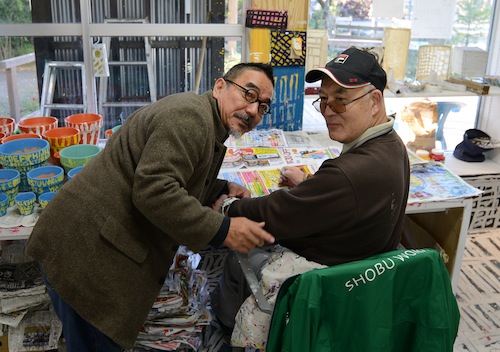
from Japan vol. 70 2015.03.23 Developing welfare design that defies conventional wisdom - SHOBU Gakuen
![]()
The creativity of people with intellectual disabilities is extremely pure and powerful. Although they may need support day to day, there is a lot we can learn from them spiritually. Based on this belief, SHOBU Gakuen (Campus) in Kagoshima is helping to realize an inclusive society that respects an individual's freedom, rather than paternalism, which at times may overstep boundaries. People who are able-bodied tend to get too distracted by comparisons and competition with others, and modern day society faces numerous issues because of this. But there is so much we can learn from people with an impairment, from their unwavering attitude, their humanity, and their love for peace. I spoke to the director of the facility, Mr. Shin Fukumori who showed me around the school.
(text by Mitsuko Iwai)
目次へ移動 The impact of imperfect sound
On December 5, 2014, I went to the live performance by SHOBU Gakuen 's musical band, "otto&orabu," and by Mr. Masakatsu Takagi, which took place at the National Museum of Emerging Science and Innovation in Odaiba, Tokyo. The members of the band were very much looking forward to their first performance in Tokyo, but so were the audience so much so that even before the concert began, the seats were completely full and there were many standees. The concert was filled with passion and excitement from the beginning through to the end.
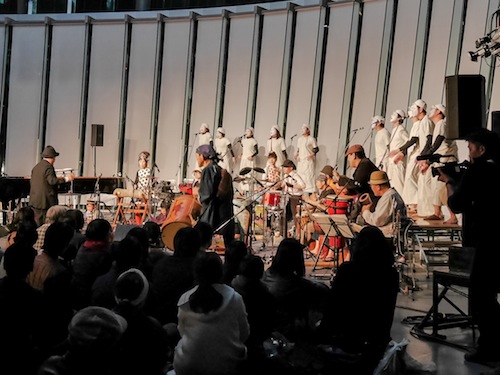 The concert was directed by Mr. Shin Fukumori. Every member of the band did a fantastic job. © KOBO SHOBU 2014
The concert was directed by Mr. Shin Fukumori. Every member of the band did a fantastic job. © KOBO SHOBU 2014
Mr. Fukumori had wondered if "music that is perfectly in synch is the only type of music that is beautiful? That is how the otto&orabu was born. There is no detailed musical score. People with disabilities play their instruments very freely, as they wish, and step to the rhythm. Although the notes and rhythm may be off at times, the mystical ambience of the song intricately weaves the imperfect sounds together, and before you realize, you have been transported into the world created by otto&orabu.
The band became instantly popular when its cover of the song, "Pompidou - Song of a Clown," was used for the fashion brand, niko and...'s TV commercial. They also performed this song near the end of the concert. It was a very powerful performance with complex layers of sounds created by the accordion, pianica, xylophone, percussion instruments like djembe and gamelan, combined with dynamic dancing, and the shouts of orabu with white painted faces.
Even with painting, woodworking, and needlework, SHOBU Gakuen has gone beyond simple workshops to develop a truly creative world of expression. Like otto&orabu's music, the SHOBU Gakuen bridges the gap by promoting the sensibilities of people with disabilities without trying to constrain it in any way. Wanting to learn more about the SHOBU STYLE, I made my way towards Kagoshima.
目次へ移動 World-leading welfare design
Once I landed at the Kagoshima Airport, it only took me 30 minutes by car to get to the SHOBU Gakuen. From the highway I could see smoke rising from Mount Sakurajima, and it hit me that I was really in Kagoshima. The social welfare corporation Taiyo-kai, "SHOBU," which runs SHOBU Gakuen, is located in the environs of Kagoshima City, in one area of the Yoshino Highlands.
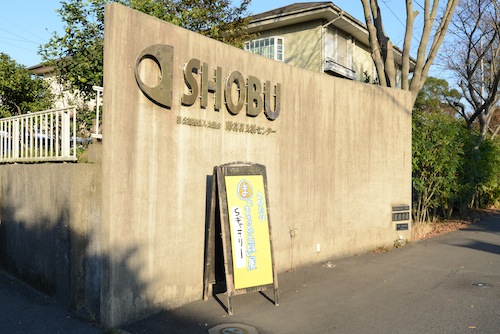 Front entrance of the campus.
Front entrance of the campus.
The first thing you see when you enter the gates is the popular sign for the bakery, "Pompidou." Mr. Yuji Ito, who works at the bakery, has been writing the specials and messages down on this blackboard since 2007. The board has a mysterious appeal. It starts with the weather and news topics that he is interested in, as well as ethical messages such as "Let's be nice to women and children." His messages from the past have become a book called, "Carillon Blackboard Diary."
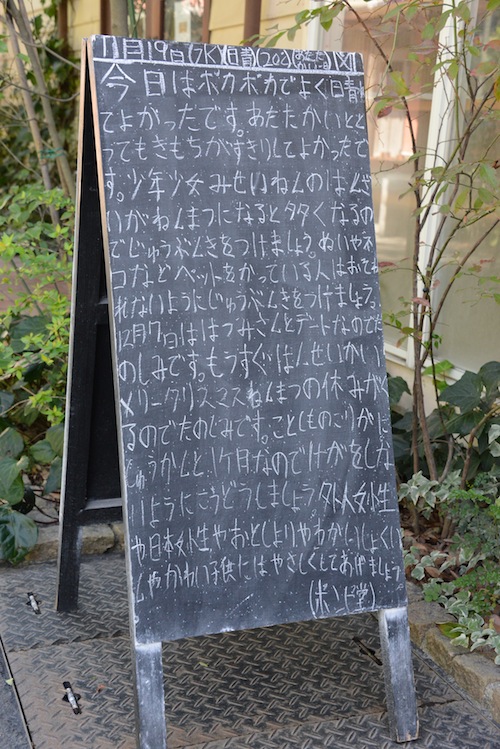
The SHOBU Gakuen's property measures approximately 8,700m2. The campus was established almost 40 years ago, in 1973, as a rehabilitation center for people with intellectual disabilities. In the beginning, it was mainly a workshop where they made Oshima-tsumugi textiles and bamboo crafts on consignment. But during the 1980s and 1990s they began a more unique, distinctive initiative, the "Craft Center SHOBU," which focused on encouraging and bringing to light the extraordinary creativity and behavior of people with disabilities through the products they make.
Business has now grown to include 3 different programs - a program that empowers people with disabilities and helps nurture their self-reliance, a program that helps create a culture, and a program that encourages communal ties. The campus' key loadstar, "SHOBU STYLE," which helps people with disability live in a way that allows them to be true to themselves, is also the name of this center and represents all of the businesses that they undertake.
The Gakuen welcomes a total of 120 students. There are dormitories, group homes, and day service centers within and near the premises, and there are about 40 people living in these facilities. And the remaining students commute from their own homes or other group homes. It was only a few years ago that the delicious soba noodle shop now loved by many people of the community opened. Now, there are more food workshops where students can work.
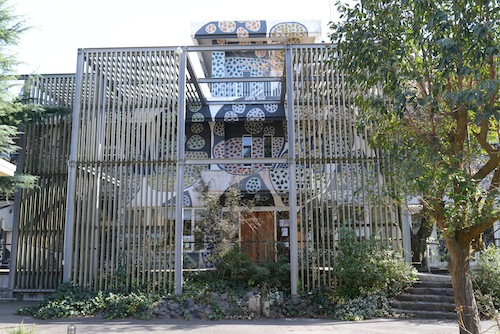 This is the communal space, "Omni House." The building is decorated with a big painting created by Ms. Nobuko Onaga who attends the painting/sculpting workshop.
This is the communal space, "Omni House." The building is decorated with a big painting created by Ms. Nobuko Onaga who attends the painting/sculpting workshop.
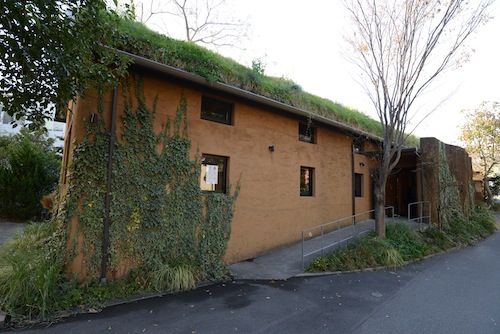 "nui Workspace" is a sewing workshop, which underwent renovation in 2011. The roof is covered by grass and the building looks like an underground room that is found above ground. It's some how a bit humorous.
"nui Workspace" is a sewing workshop, which underwent renovation in 2011. The roof is covered by grass and the building looks like an underground room that is found above ground. It's some how a bit humorous.
I had some time until I was supposed to meet Mr. Fukumori, so I decided to grab some lunch. The wooden plates with a warm look and feel were all handcrafted at the workshop. And the people working in the restaurant were very polite and thorough.
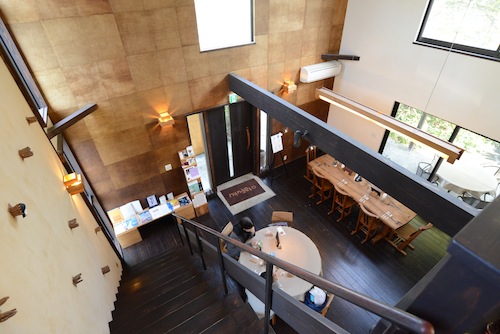 Inside the pasta and cafe, "Otafuku." The open cafe has a high vaulted ceiling. The wallpaper near the entrance was hand dyed with Oolong tea. The walls were also decorated with handcrafted sea anemone like ceramic sculptures.
Inside the pasta and cafe, "Otafuku." The open cafe has a high vaulted ceiling. The wallpaper near the entrance was hand dyed with Oolong tea. The walls were also decorated with handcrafted sea anemone like ceramic sculptures.
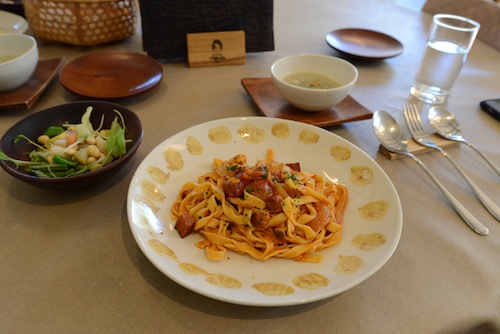 Their hand-kneaded pasta is very popular. Several women of the local community were having a nice relaxing lunch.
Their hand-kneaded pasta is very popular. Several women of the local community were having a nice relaxing lunch.
目次へ移動 When we began thinking about their freedom everything changed
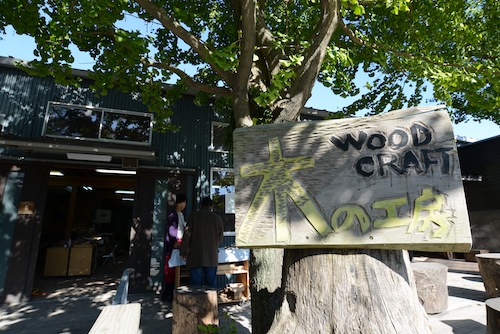
Mr. Fukumori first took me to the woodworking workshop near the edge of the Gakuen. The SHOBU Gakuen was established by Mr. Fukumori's parents, and Mr. Fukumori the youngest child is son and heir. After graduating from university, he spent time walking the earth in the U.S. and worked part time in Tokyo before returning home. He established this workshop when he started working at the Gakuen in 1988. It is equipped with facilities for making furniture like chairs, and people can even use lacquer.
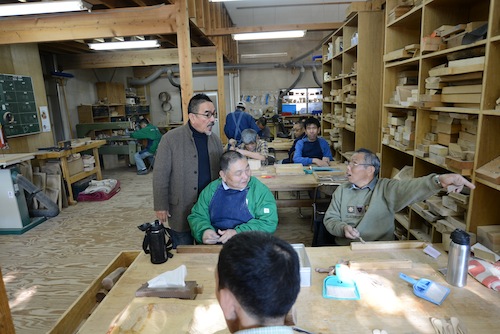 Everyone breaks into a smile when Mr. Fukumori enters the workshop.
Everyone breaks into a smile when Mr. Fukumori enters the workshop.
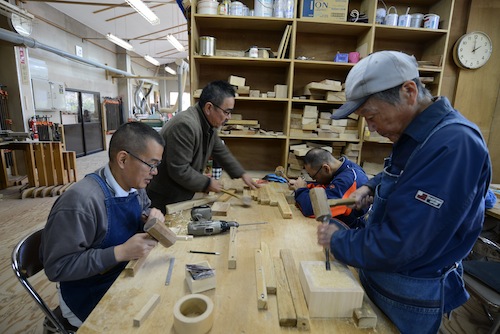
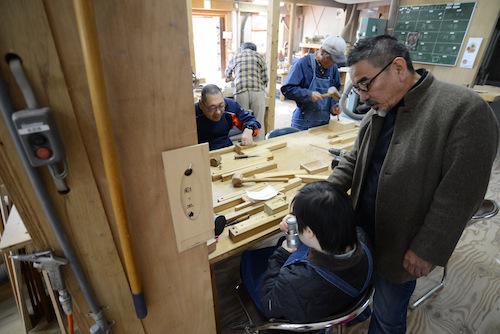 Mr. Fukumori asked them jokingly, "Could you fill my thermos with some alcohol?" He has a natural talent for making them feel at ease.
Mr. Fukumori asked them jokingly, "Could you fill my thermos with some alcohol?" He has a natural talent for making them feel at ease.
In the workshop, there are people who sculpt wooden containers with chisels, others who like sanding, and some who cut out wooden buttons with an electronic saw. Inside, there were Gakuen staff, people who were receiving job assistance, and students who simply enjoy woodwork, but you can't tell who's who at a glance.
"At first, I was trying to get them to make something," Mr. Fukumori explained. But some people didn't know how to "moderate," so they chiseled right through the wood until there was a hole or made small woodchips and excitedly said "I' done!" Mr. Fukumori tried setting timers depending on the individuals' progress to let them know to stop chiseling when the alarm goes off, but this was also futile.
"What I was trying to do was, in a sense, creating a machine for making products. I thought to myself, what am I doing? They didn't want to create containers. Even if our staff wanted them to make containers, and told them they'd gone too far, they hadn't had enough; they still wanted to chisel away. But we were unilaterally telling them that they'd chiseled too far. I realized that this was a great imposition. We were not respecting their wishes and this was not at all what they had intended."
Mr. Fukumori thought very long and hard. If all the users had to make the same product, some products would be better than others depending on the severity of their disability. So in what other ways could we improve productivity?
That is why they began to give users greater freedom of expression. They were able to do what they could, like scratching or beating the surface of the wood with saws and hammers. These would be considered "decoration" and the staff would make trays and other products with the wood. In other words, they stopped applying logic that normally applies to able-bodied persons. And pressures like quotas, the staff dealt with, rather than the students. By doing so even people with a severe impairment can "create." The new system that he had developed made this possible.
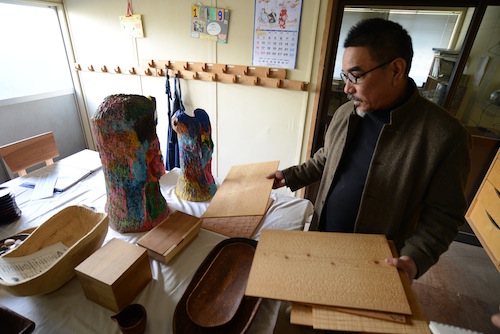 "Just as we are free, they also deserve to be free," says Mr. Fukumori.
"Just as we are free, they also deserve to be free," says Mr. Fukumori.
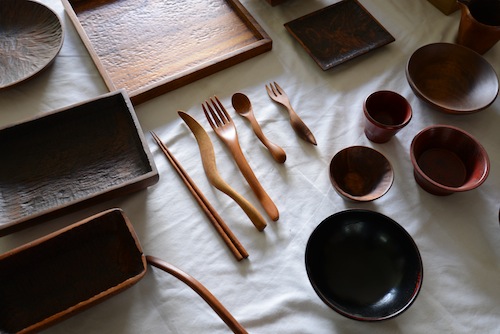 A wide range of unique, one-of-a-kind wooden products.
A wide range of unique, one-of-a-kind wooden products.
All of the handcrafted products made by people who come to the Gakuen are very attractive, but I was surprised when I heard that this was because these products were placed in galleries located far away from Kagoshima, all across the country, and the creators honed their skills by being open to people's feedback and preferences.
"We're much more calculating than they are. We are more concerned with what people think and about money so we tend to meander" explained Mr. Fukumori with a lopsided smile. "Of course limits are great for our health. For example, its better not to eat too much, stay in the bath too long, or do too much of one thing. But I began to realize that manufacturing enables them to express themselves, their way of life and values without any limitation. Although they may chisel the wood down until there is nothing left, even that now seemed beautiful. They never stray from their path, and they don't change. But our way of thinking had significantly changed, and this gave way to a brand new start for SHOBU Gakuen."
目次へ移動 The sadness of completion
Mr. Fukumori had talked about the "beauty of their behavior." But it was in the sewing workshop that this was most apparent.
The "nui project," which began in this workshop, has been very highly praised in an exhibition held in Oakland, USA in 2003 and in galleries across Japan. The students had stitched the fabric over and over again until it shrunk and took on a third dimension. This project started when Mr. Fukumori's partner, Ms. Noriko, who used to work in the sewing workshop, saw a piece of fabric on the floor and thought, 'But this is very pretty.'"
Of course these pieces created by students who can't sew straight would be considered "defective" when considered a part of contract work. But after much deliberation, Mr. Fukumori and his team decided to let the students stitch as their hearts desired. And this is how their powerful, unique stitching blossomed across the world.
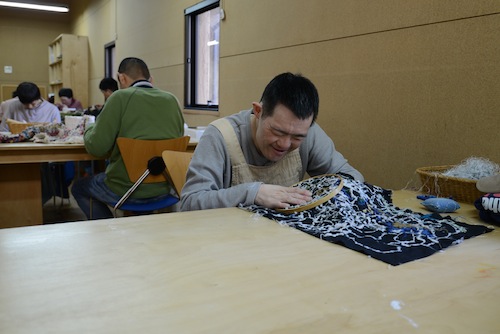 They look extremely happy.
They look extremely happy.
Inside the workshop lay a world of "stitching" that surpassed my imagination. Not a single student mimicked others. They were completely absorbed with their own way of stitching. Their spiritual world was reflected not only in the works of art they had created, but also in the way that they created their pieces. The sight I saw gave me goose bumps; it was as though there was a direct link between their hearts and their hands.
Ms. Kayoko Uchimura, who works in this workshop explained, "The works by students may be framed and displayed as is or the staff may finish it up with a sewing machine." Collaboration projects like T-shirts and bags with daring stitch work can't be mass-produced, so the students work on these projects for exhibitions that may be 1 or 2 years in the future.
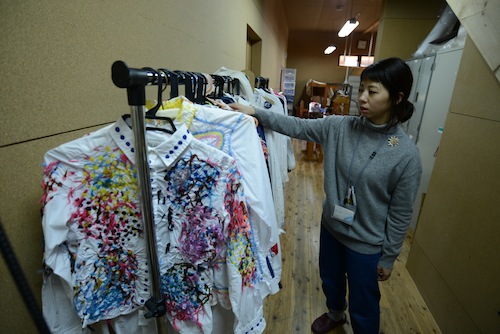 Ms. Uchimura said, "Collaboration work requires everyone's full effort."
Ms. Uchimura said, "Collaboration work requires everyone's full effort."
Mr. Keisuke Nomaguchi. He likes to stitch the white fabric with colorful yarn until you can't see the fabric anymore. Many students prefer to use new yarn, but he likes to use cutoffs that he might find in the trash. He has his own rules when it comes to the order of colors. Stitching waves and then stopping - he repeats this process endlessly.
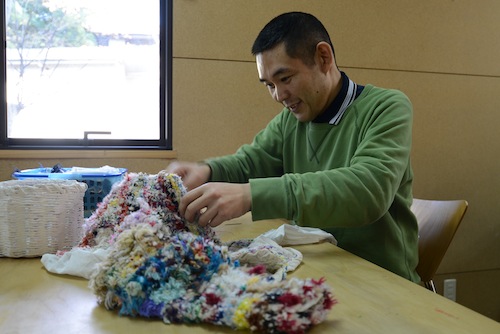 Mr. Keisuke Nomaguchi.
Mr. Keisuke Nomaguchi.
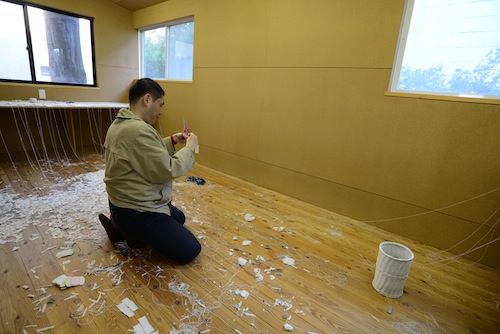 Mr. Atsushi Yoshimoto.
Mr. Atsushi Yoshimoto.
Mr. Atsushi Yoshimoto. He had created a unique world by stretching white yarn across the room from both ends of the dedicated space. He was kneeling down on the floor littered with small pieces of fabric, and he was rhythmically going about his work using a pair of scissors and his mouth. His back was towards me, so I didn't get a close look, but he seemed to be taking a piece of cloth a few centimeters wide and tying knots in the four corners.
The way Mr. Yoshimoto seemingly takes apart textile products was considered a problem at his previous facility, but he can do what he likes in this workshop and his space has gradually grown bigger.
During my tour, I began to wonder why work had become increasingly more intricate. Ms. Uchimura explained that before, Mr. Nomaguchi used to "spend a year and a half to finish his project, but it's taken him 3 years to get this far. It may take him a total of 7 years to finish it." I asked Mr. Fukumori why the students create such elaborate work when they aren't required to because there aren't rules.
"We tend to try to finish as quickly as possible, so that is why our work becomes rough. The reason why their work becomes increasingly elaborate is because I think they enjoy each and every moment that they are working on a project. We've all been on vacation and felt sad that our trip was coming to an end. Perhaps they feel the same. We feel joy when we finish a project so often times we say we've "worked hard," but they enjoy the process of creativity, so the way they work is far more beautiful than the way we work."
The sadness of completion - I had never thought of it that way. We often say that constraints are the wellspring of creativity, but our creativity is no match for theirs.
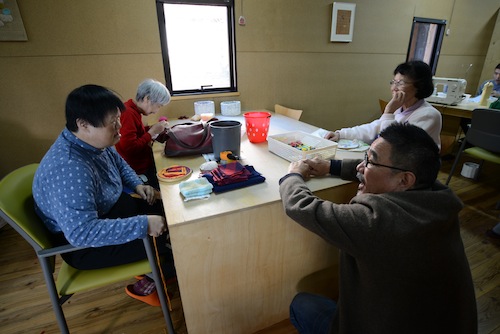 Mr. Fukumori speaking to the students.
Mr. Fukumori speaking to the students.
目次へ移動 Painting on a deserted island
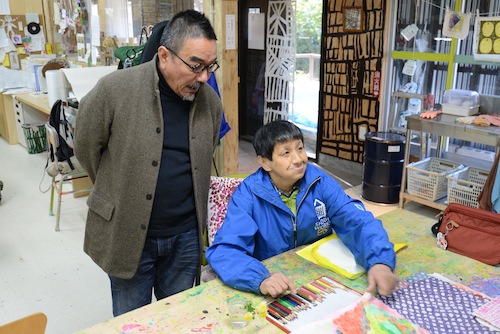 Ms. Rieko Sakashita calls Mr. Fukumori by his nickname, "Shin-chan." She is very skilled with stamp work using bamboo.
Ms. Rieko Sakashita calls Mr. Fukumori by his nickname, "Shin-chan." She is very skilled with stamp work using bamboo.
The painting/sculpting workshop was truly impressive. Although every piece was full of energy, each looked completely different. I felt humbled by how powerful these pieces, which mirrored each student's sensitivities, were.
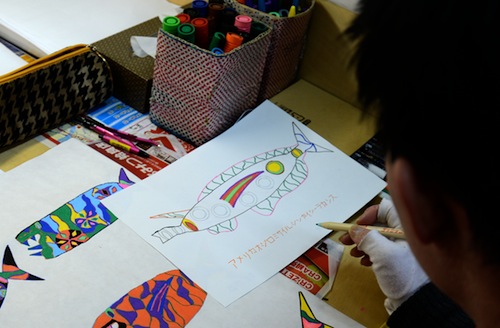 The fishes Mr. Kosei Yoshimori paints are like aboriginal art. He has named this painting, American White-Tailed Missile Deep-Water Coelacanth. He creates such a wonderful world.
The fishes Mr. Kosei Yoshimori paints are like aboriginal art. He has named this painting, American White-Tailed Missile Deep-Water Coelacanth. He creates such a wonderful world.
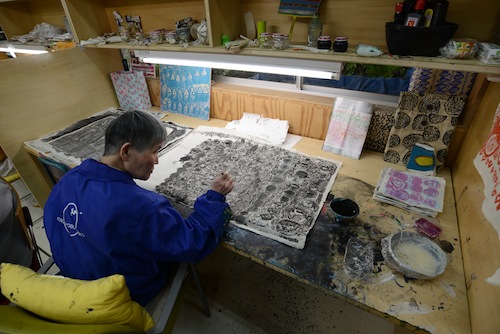 She is Gakuen's legendary artist, Ms. Nobuko Onaga. She likes the combination of ink and washi (Japanese) paper. She is known for bamboo shoot like shapes with fine dots inside. "Recently she seems to prefer very watered down ink," explained Ms. Tomoha Suzuki, the coordinator of the workshop.
She is Gakuen's legendary artist, Ms. Nobuko Onaga. She likes the combination of ink and washi (Japanese) paper. She is known for bamboo shoot like shapes with fine dots inside. "Recently she seems to prefer very watered down ink," explained Ms. Tomoha Suzuki, the coordinator of the workshop.
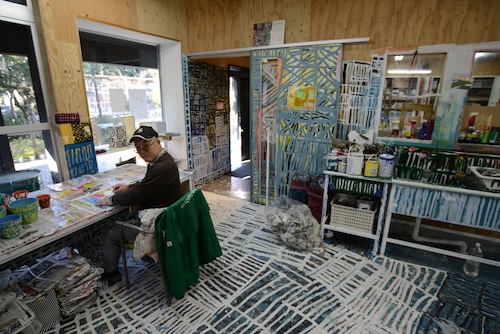 Mr. Mikio Hamada in his very own studio.
Mr. Mikio Hamada in his very own studio.
Mr. Mikio Hamada is another artist who has displayed many of his pieces at the conceptual exhibition, "Art as a Haven of Happiness," organized in the Tokyo Metropolitan Art Museum. He has his very own studio. Because he suffers from a narrow visual field, he prefers high contrasts. He paints a large square, and creates a motif within with lines. The floors, doors, and sink are also his creations. It was truly breathtaking.
Mr. Fukumori told me the following story. "A few days ago I had an interview with Mr. Gyoji Nomiyama, an oil painter who has received the Order of Culture. He told me that he wondered if he would continue to paint if he were stranded on a deserted island. He was asking himself if he could express himself purely without worrying about what other people may think. When he came to the Gakuen and saw the students at work he said, 'They would definitely continue to paint. I envy them.'"
The artist known for the "Tower of the Sun," Taro Okamoto once said, "Endless self-reflection - this is the essence of art and a way to reclaim our humanity." Mr. Fukumori explained that Ms. Onaga and Mr. Hamada whose works are already masterpieces of art, are very much like Taro Okamoto. "They believe in themselves, and they are very happy with what springs forth from within. They don't care whether they receive praise or not. They are truly impressive. And they don't even refer to themselves as artists or their creations as art."
目次へ移動 We're neurotypical
The creativity of people with an intellectual disability is very eloquent and full of energy. I also realized that their expressions without a hint of contrivance have the power to reawaken a primitive sensitivity that lies dormant within us.
Mr. Fukumori explained that the Gakuen's path changed when their way of thinking changed, but I wanted to better understand what triggered this, what made him decide to adopt this daring policy of "not teaching."
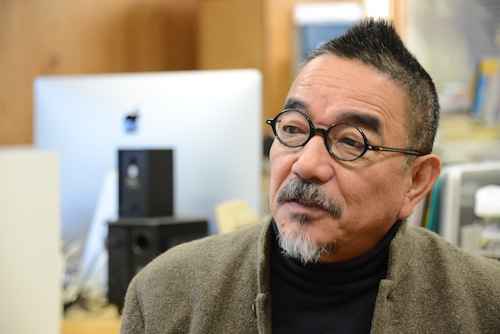
"Recently, I have begun to use the word, neurotypical. People with a type of autism known as Asperger's syndrome refer to people who are not on the autism spectrum as being neurotypical (or allistic). Being atypical,autistic people think of allistic people as people who 'sometimes lie,' 'twist the truth to suit their own needs,' and are 'influenced by trends.' From where they stand, this certainly seems like an impairment."
"When we think of it this way, the boundary between the 2 groups seems less prominent. It's better to think of us as 'having been coincidentally born without any impairment.' When we call ourselves able-bodied, we're saying that we are normal, and they are atypical. But may be it is us, who are deviating more and more from the norm - we keep fighting wars, and we continue to do things that don't make sense. And if this is the case, we shouldn't impose our standards on them. I began to think that may be we were trying to force them to be more like able-bodied people and thereby forcing them to lose their humanity, which was not at all what we wanted to do."
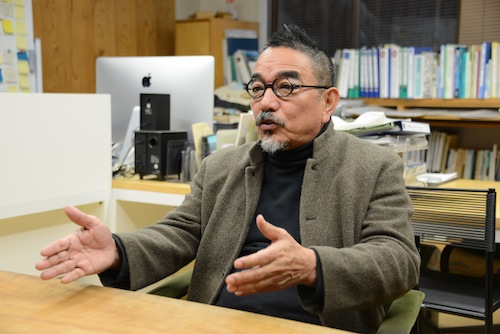
"The majority opinion may be the general, mainstream belief, but that does not mean that it is right. May be they are right, even though they are the minority. There may be many things that they are unable to do day to day, but they lead very humane, very peaceful lives. We should all learn from that. That is how I feel now."
Stripping off our preconceptions and thinking about things more relatively, we can better understand their true intentions and bridge the gap. And, of course, nurturing creativity at the same time. The fact that they made such a grand transformation involving the entire Gakuen is quite impressive.
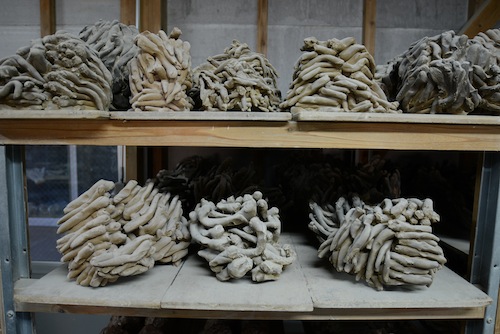 In the soil workshop. The pottery that looked like a deep-sea fish caught my attention.
In the soil workshop. The pottery that looked like a deep-sea fish caught my attention.
Then we began talking about how the 2 groups, how neurotypical and atypical are easy to understand, but perhaps they are simply on different ends of the same spectrum. Even people who are neurotypical can be creative if they are not restricted by the left side of the brain, which governs logic, common sense, and languages. May be there is an atypical side to us that we're unconsciously hiding away. And if so, we're not so different from them.
Whether it's good or bad, modern day society revolves around neurotypical thinking. But compared to society's axis, the Gakuen's axis lies more in the center, in between the 2 groups. Mr. Fukumori said that this was an "inevitable progression."
If only we could shift our values more in their direction, then we may discover tips on how we can create a society where we can better coexist, a world that is more inclusive.If you think about it, there is no doubt that many of the groundbreaking inventions and expressions were created not by people who are extremely neurotypical, but by people who sit right on the borderline of the 2
目次へ移動 Closer to their happiness
In 2013 the Gakuen celebrated its 40th anniversary. Mr. Fukumori wrote the following for the epilogue of the commemorative magazine.
We are not in any position to teach them about social order. Rather, we should learn from them about spiritual order. What we must do is to create a safe passage for them.
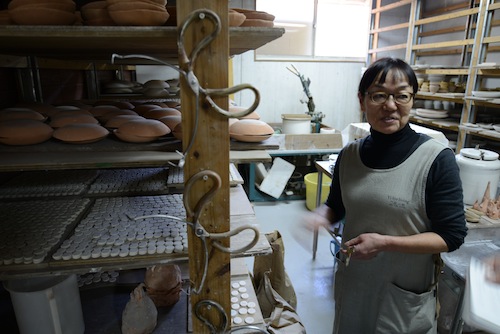 Ms. Izumi Fukumori, Mr. Fukumori's older sister, helps out in the soil workshop.
Ms. Izumi Fukumori, Mr. Fukumori's older sister, helps out in the soil workshop.
What moved me, having visited the many workshops, was the way the staff worked to support the students. No one had any professional training in art, but they treated the students as equals, working together on their collaboration work, fulfilled the production quota, kept an eye on the students' health, and also helped navigate their relationships. The staff need to be multi-talented. They need to be able to focus, yet be observant, and be quick on their feet.
Respecting each student's freedom means keeping a close eye on them, much in the same way that a mother may tend to the needs of a child, who has yet to learn to speak. Mothers are always very attentive, and they can tell if something is wrong or different from the child's expressions and behavior, even if they can't communicate with words.
Mr. Fukumori explained that the people who can, in a good way, get inside a person's head or heart, like a mother, had a knack for helping others. How deep one can go also depends on the person's natural talent.
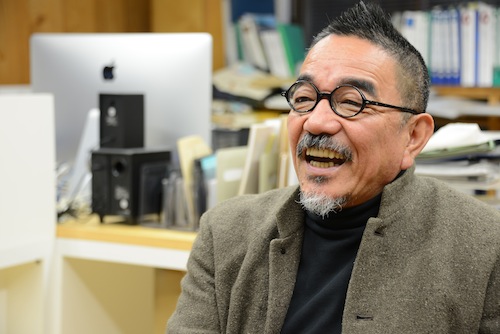 "Our job is to create an environment that helps them keep smiling," said Mr. Fukumori.
"Our job is to create an environment that helps them keep smiling," said Mr. Fukumori.
In recent years, the Gakuen has opened numerous sites that help promote exchange and communication with the community. But like the trajectory that their manufacturing efforts have followed, in trying to promote exchange with the community, the Gakuen is trying to think of a way that helps the students stay happy, rather than be confined by national systems and policies, or by management of a social welfare corporation.
"We may discover that what we want to do may not align with existent systems, but we're not too concerned about that. That's just something we'll work to change."
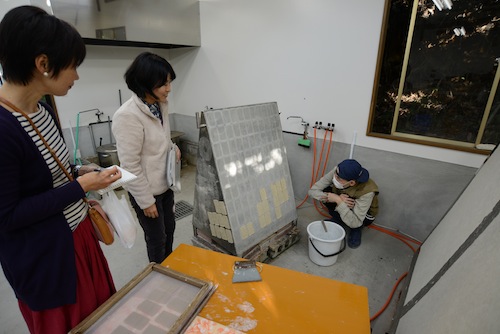 Mr. Manabu Wakikuro was humming a bright tune as he worked in one corner of the washi (Japanese paper) workshop. His favorite artist is Teresa Teng.
Mr. Manabu Wakikuro was humming a bright tune as he worked in one corner of the washi (Japanese paper) workshop. His favorite artist is Teresa Teng.
Mr. Fukumori has known since junior high school many of the students who come to the Gakuen. "I've been telling the same jokes for about 30 years now. But they are kind enough to still laugh at them. If you asked me what they want in life in the future, I don't think that they want much. But may be they should. May be it's not enough to be happy all the time. What does it mean to grow?"
Through its welfare design, the SHOBU Gakuen has successfully and creatively "united" a wide spectrum of values. And Mr. Fukumori believes that the Gakuen's welfare design has the power to impact today's complex society. We may not be able to express ourselves as creatively as they can, but there is so much we can learn and absorb by coming into contact with their honest, instinctive way of life. The world today tends to be governed too much by greed. By seeing how these people live, we can, at least, reflect deeply on what is wrong with modern day society's core values.
Related Website:
SHOBU GAKUEN (Japanese) http://www.shobu.jp
Mitsuko Iwai biography:
She has worked for a local museum/news paper publisher before she became a freelance writer in 2001. She is an editorial staff of Think the Earth Project's Earth News, and works on Lumine choroko's free paper, "ecoshare," Ethical Fashion College's reports, and on the "Water Literacy Open Forum" reports for the International Christian University: Institute for Educational Research and Services. She currently lives in Takasaki.
Report and text by: Mitsuko Iwai
Photographs by: Soichi Ueda (Think the Earth)
Translated by: Yuri Morikawa (oxygen inc.)















